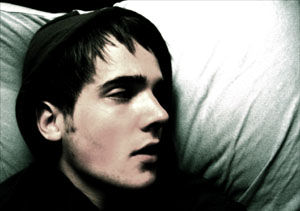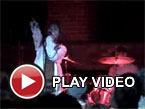 Lucas Schleicher: Tell us a little bit about your upcoming tour. How did it come to be?
Lucas Schleicher: Tell us a little bit about your upcoming tour. How did it come to be?
Thomas Meluch: Sylvia (the agent/promoter in Paris who is handling everything) first approached me about some French dates a couple of years ago, at which point I wasn't nearly confident enough in the live aspect of my music to dive in. Earlier this year, though, I had what I consider a very successful tour in the US with Windy & Carl, by which time I was using vocals and doing things about which I was much happier. After that I heard from Sylvia again and was feeling ready to do a lot more live playing, so we began planning and have been sewing things up for the last 5 months or so.
LS: Have you ever been to Europe before? Do you have any expectations for what it will be like performing there? Any goals?
TM: As with the previous tour, I am allowing myself not to have any expectations about how things will go down. I have indeed been to Europe on a few occasions before - two weeks in France, a summer studying in England, and so on - and am definitely excited to be back there. My primary goal is to play all my songs (most of which are new) correctly and hopefully match the energy in the room at each performance.
LS: Last time I saw you perform your music was a bit more improvisational and noisy than I expected. At the very least I think it is fair to say your live performance emphasized very different musical elements than the ones on your records. Can you explain why your performances are so different?
TM: The easiest explanation would be the difference in tools I use to create recorded and live pieces - at home I have several guitars, various other instruments and some software to deal with what I'm making, but live I'll be using a single guitar, vocals, tapes and a set of pedals that all run in real-time. That aspect makes me feel more at ease with improvisation, though the set I've been developing is guided/anchored by 6 or 7 proper songs in between which anything else might happen.

LS": "Alaskan Lashes" (from the Flocks 7" EP on Blue Flea) shocked me a little bit, but reminded me of your live set, too. Textured sound and noise play significant roles on your records, but not to the same degree found on that song. Can you talk a little bit about "Alaskan Lashes" and how it came about? What motivated you to release an all-noise piece?
TM: Knowing that it'd be on Blue Flea (run by Windy & Carl) gave me the sense that something a little noisier might be appropriate to balance out the comparatively straightforward A-side, and that one was a pretty organic creation from what I recall. In a sense it's a documentation of the house in which I was living at the time, since most of the sounds (apart from the guitar & cello drones) are taken from its environs, albeit heavily treated and EQ'd to sound like the tundra.
LS: Can we expect more songs like that from you in the future?
TM: I wouldn't rule it out, certainly.
LS: Can you talk a little more about the live setup you will be using in Europe? Is there anything you're actively working to change about it?
TM: As I briefly mentioned, I'll be using a single guitar, four effects pedals, vocals and some base layer tape recordings collected over the past months - after years of switching tunings for almost every song, I've managed to arrive at a single tuning in which I can play all the songs I've arranged, which makes things easier. I'll primarily be taking the train between dates, so I aimed to keep the setup as minimal as possible for this jaunt while still allowing room for a palette of improv and treatment options. I prefer not to stop in between songs so the set list (such as it is) is ordered by ease of transition, like at the end of one song I can harmonize with the final chord and lead into the next piece, for example.

LS: Last tour you brought some beautiful photographs with you and I understand that fans responded to them very well. Are there any treats concert-goers can expect from you this time around?
TM: I'll be selling more sets of those photo cards and handmade envelopes, as well as a handful of copies of a very limited (30 copies) noise collaboration CD I made with my friend Actual Birds, in addition to the new 7" and the Kranky full-lengths. I'm also very pleased with the projection visuals I've prepared for these shows and there will be different ones at different venues, just to keep things varied.
LS: Speaking of projections, during the last tour you had some wonderful black and white footage accompanying your performance. I remember pistons, industrial sites from the early 20th century, steam engines, and other such imagery. Who was responsible for those images and why did you choose to use them?
TM: That reel was an edit of two great films I found while delving archive.org, easily one of my favorite sites. There was something darkly beautiful about both; one a documentary about steel production, the other a newsreel of the aftermath of a B-52 crashing into the Empire State Building in 1945. Humans accounting for themselves & the costs of industrial progress.
LS: I've read before that Terrence Malick, among other directors, has influenced your music (and maybe your photography). What is it in the films you enjoy that find their way into your music? Do you think there is an inherent relationship between film and music? What would that be?
TM: Malick is an unimpeachable genius in my opinion; the subtle complexities of his characters unfold with incredible grace and realism, and his direction and cinematography do something to my brain that no others do. I've seen Badlands at least a half-dozen times and still notice remarkably understated details that serve to enrich the overall feel and themes of the film. He understands the link between man and his natural surroundings: that we're all flawed, innately brutal creatures with endless potential for good, and all of that comes through in his work without so much as a glimmer of heavy-handedness or overtness, which I find truly impressive. The music in Badlands is also essential to its course, from the gorgeous atmospheric pieces to the jaw-dropping scene where Nat King Cole's "A Blossom Fell" plays, the interconnected diversity of sounds makes total sense.
LS: From what I've seen, there's a striking isomorphism between your own photography and your music. Do you think of them as related endeavors?
TM: Definitely, I mean it all adds up in my brain, comes from the same place, so I'm excited by the thought that it might make sense like that to others. It's all a (vain) stab at harnessing my surroundings and the circumstances of my existence, although for no particular justifiable purpose.
LS: Are you and Windy Weber still working on Lamb's Laughter material? How did that come about in the first place?
TM: We are! She was here at the end of the summer and we recorded



